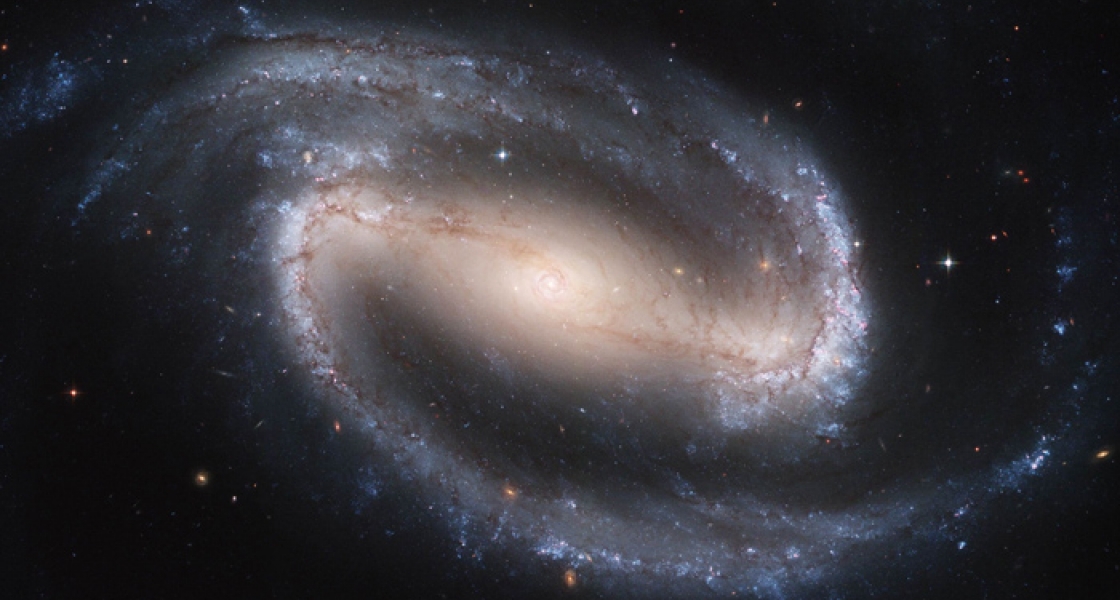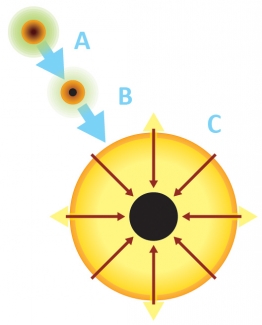There is an enormous black hole at the center of every galaxy, gobbling up matter over eons of time - some for as long as 13 billion years. One of the great questions of modern astronomy is: Where did the seeds for all these black holes come from? Not, as you might think, from the fiery collapse of massive hot stars formed in the early Universe, says Fellow Mitch Begelman. That may well be how new, much smaller black holes are formed, even now. However, despite long-standing theories to the contrary, Begelman believes that ancient supernovae cannot account for the genesis of the black holes as massive as a million suns at the center of galaxies.
Rather, he says, the seeds for these supermassive black holes were created during the formation of the galaxies themselves. The black holes formed at the centers of huge, but dense, reservoirs of mostly dark matter coupled to ordinary matter, mostly hydrogen gas. The formation of galaxies with massive black holes at their centers occurred millions of years after the Universe spawned its first stars.
The formation of galaxies began when the gas cooled down enough to decouple from the dark matter and fall towards the center under its own gravity. Rotation hindered its collapse at first, but eventually the rotating gas became unstable and formed a bar, similar to the one shown above. Bar formation rapidly transferred the angular momentum of the disk further away from the core. As the gas lost angular momentum, it moved inward and became even more unstable. New bars formed within old bars in discrete steps, like a set of Russian dolls nested inside one another.
The "bar within bars" process was proposed by Isaac Shlosman, then a JILA postdoc, JILA Visiting Fellow Juhan Frank, and Begelman in 1989 and refined in 2001-2002 when Shlosman was a Visiting Fellow. The researchers now posit that this process led to the creation of a dense, self-gravitating core supported by gas pressure. The core eventually got so compressed that radiation was literally squeezed out of it, causing its outer envelope to begin to shine and signaling the creation of a quasi-star. Quasi-stars were very hot and even more luminous than the Pop III stars, the earliest stars that formed in the Universe.
However, a quasi-star's dazzling brilliance lasted only a few thousand years. Even the inefficient nuclear reactions that started within the typical quasi-star weren't strong enough to counter the intense gravity it experienced and inflate its core. Instead, as the core got more compressed, it continued to get denser and hotter. Soon, the core got hot enough to radiate neutrinos, which caused it to lose its internal pressure. The core then collapsed into a black hole with a mass equal to 10-20 Suns.
The newly formed black hole was surrounded by most of the mass of the quasi-star - equivalent to at least 1000 Suns. The black hole started swallowing this material at an incredible rate. However, some of the matter falling toward the black hole grew hot and energetic enough to escape the black hole's gravitational pull. This escaping matter puffed up the quasi-star, expanding it at least a hundredfold (from its original diameter the size of Earth's orbit) in a period of only 10-20 thousand years.
As the quasi-star expanded, it became cooler, forming a yellow giant star composed entirely of hydrogen and helium. Eventually, the nearby black hole overwhelmed its ability to radiate away energy, and the quasi-star began to evaporate. Just before it evaporated, the quasi-star would have had not only a predictable spectrum, but also a well-defined temperature somewhat below that of the Sun's surface. The evaporation of the quasi-star slowed the growth of the black hole, which by then had a mass between 10,000 and 100,000 Suns - a very large seed indeed at the center of every galaxy in the Universe.
Thus, according to Begelman's theory, were sowed the seeds for the creation of supermassive black holes. The good news is that the new theory predicts that the James Webb Space Telescope, scheduled for launch in 2013, should be able to detect and identify the remnants of the ancient yellow giant quasi-stars in nearly every field of view of its infrared telescope. At high redshift, the giant yellow stars will look like pure radiating black bodies, says Begelman. - Julie Phillips





